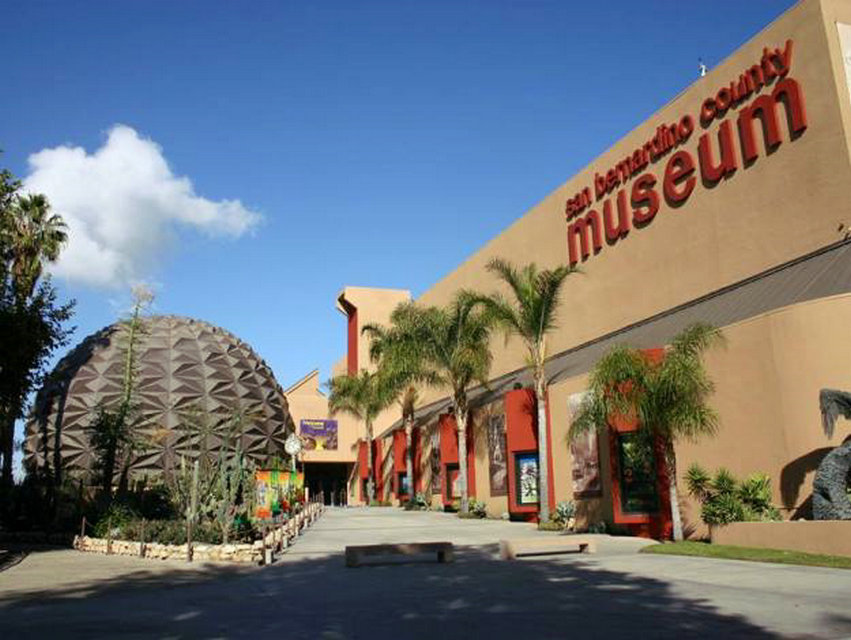San Bernardino County Museum, Redlands, United States


The San Bernardino County Museum, in Redlands, California, is a regional museum with exhibits and collections in cultural and natural history. Special exhibits, the Exploration Station live animal discovery center, extensive research collections, and public programs for adults, families, students, and children are all part of the museum experience.
Mission
Through the lens of the region’s dynamic cultural and natural history, the San Bernardino County Museum develops visitors’ appreciation of our diverse regional identity to spark their curiosity, to stimulate inquiry, to challenge their assumptions, and to invite them to contribute to our common future.
Core Values
Public Service: We exist to better the lives of the citizens in our region.
Diversity: We promote and celebrate the rich complexity of our region’s past, present, and future and provide a welcoming, safe, and intellectually honest space for all people.
Engagement: We provide our community the opportunity for active participation and reflection in our programs and exhibits.
Integrity: We abide by professional ethics, honesty, and transparency.
Competence: We take seriously our role as stewards of our region’s legacy and are methodical in our collections practices, educational programming, and professional development.
Responsibility: Our practices promote fiscal and environmental sustainability.
Collaboration: We believe our community needs can be most successfully met through partnership with individuals and organizations committed to our mission.
Our mission and core values form the foundation for our Strategic Plan for 2017 to 2022.
The San Bernardino County Museum was founded in 1952 by the San Bernardino County Museum Association. It opened to the public in 1957, and was donated to the County of San Bernardino in 1961. The facility moved from Bloomington, California to its present location in Redlands in 1974.
The Museum currently exists as a department of the County, under the Community Services Group. Additional branch sites include the Victor Valley Museum in Apple Valley, the Asistencia in Redlands, the Yucaipa Adobe, the Agua Mansa Pioneer Cemetery in Colton, the Yorba-Slaughter Adobe in Chino, and the John Rains House in Rancho Cucamonga.
The main museum in Redlands contains exhibits exploring cultural and natural history. Special exhibits, the Exploration Station live animal station, the Learning Depot, native plant and cactus gardens, citrus groves, curatorial offices, and research and reference collections all comprise the museum offerings for adults, families, students, and children.
Main Level
Hall of History
Walk a path through Sacred Earth to see baskets, pottery, tools. Share vibrant cultures of our distant past, our present, and our future. All roads lead through San Bernardino. See a Mexican carreta, a covered wagon that crossed the Mojave Desert from Salt Lake City, horse-drawn buggies, and historic automobiles that featured in the discovery and development of Inland Southern California.
Hall of Earth Sciences Sacred Earth
A life-size mastodon and her calf will introduce you to an amazing array of fossils that represent millions of years of life in our area. Learn about plate tectonics and understand why The Big One is such a timely topic in southern California.
Fisk Gallery
Changing exhibits line the walls inside our geodesic dome, which is also used for lectures, meetings, and special activities. Please go to our events calendar for details.
Administration offices and the Museum Store are also located on the main level of the museum, as are the Welcome Desk, restrooms and drinking fountain.
Hall of Biodiversity
Sample the amazing diversity of life in our region: birds, mammals, reptiles, and amphibians. See an outstanding collection of mounted birds from inland Southern California, both residents and migrants. Meet some of the mammals that live in our mountains, valleys, and deserts, and learn how climate and geography combine to create habitats that support a diverse fauna and flora.
Water Bird Hall
Fresh water and salt water habitat displays from the shores of California north to Alaska hold mounted specimens of water birds. Eggs and nests are also displayed, and bird songs may be heard through an interactive exhibit.
Hall of Earth Sciences
The upper level of the Hall of Earth Sciences will soon let you walk through the geology of the Mojave Desert: caves, lakes, playas, mountains, and alluvial fans.
Schuiling Gallery
Sometimes it’s a special exhibit, sometimes it’s a program . . . but there’s usually something going on in the upper level of our geodesic dome. Just outside in the hallway, don’t miss our California Condor that died an accidental death more than 60 years ago and stands as a reminder of our vanishing wildlife.